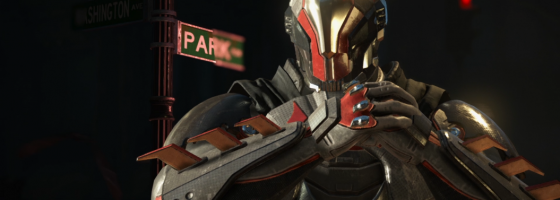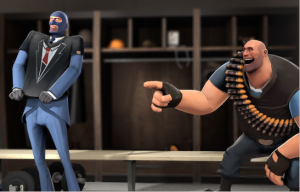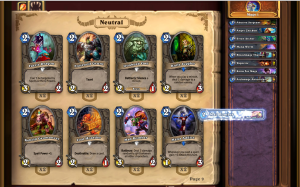Recently it was revealed that not only is there going to be a new Injustice game, but the developers are going big with meta-game progression for all the fighters. This turn of events is surprising, because the last game to do it (Street Fighter X Tekken) did not win over the competitive crowd and E-Sports market.
Adding in content that changes the game is very tricky for games aimed at competitive-level players, and there are several factors to keep track of.
The Fighting Meta:
Fighting/competitive games are different from your other titles. The reason is that competitive players expect different things compared to other fans, and it’s important to point out the norm before we talk about meta-design.
Typically speaking, competitive players want a game that offers variety, but consistency. There should be different ways and strategies to play, but they should be from a set framework that someone can study and build successful gameplans around. This is why high level Starcraft play usually is built around set plans of build orders and army compositions that were tested and refined to be the best.
A huge no-no is having any pay-to-win elements in your game; competitive fans will leave a game in droves if the only way for them to win is to keep spending money. Characters are alright in terms of new content, because it’s something that adds to the complexity of the game without providing an “I win” button for players.

Fighting games are free to add content after release, but it has to be those meant to enhance the design
While it’s not as important as the first two points, it’s still very much expected that competitive games will be continually supported; both in terms of content and patches/balance fixes.
Games like League of Legends, Street Fighter and Netherealm’s previous hit MK 10, were all supported way past their time as new releases on store shelves.
Today, meta-game design is a major part of both progression and fleshing out games. There are so many examples of single and multiplayer games that have made use of it to extend someone’s time playing it. With that said, it’s normally something not seen in competitive-level games for the already mentioned reasons.
So the question is, how can meta-game design be accepted by competitive fans? I have a few ideas on the matter.
1. Do not do P2W
I know we already talked about it, but it begs repeating a second time. You cannot have elements that are designed to be superior and cost money if you expect competitive players to look at your game. Despite all the content and additions to League of Legends, the developers are constantly balancing new characters, old characters and anything that is considered too good.
The millisecond that you have something considered the best, the competitive crowd will flock to it; something Blizzard has been struggling to keep ahead of with Hearthstone. Every new piece of content has to be weighed with what’s existing and you need a team that is analytical enough to look at everything to make sure that nothing is superior.
While it’s debatable regarding microtransactions for content or aesthetic items, you do not want any grey areas when it comes to content that impacts the gameplay.
If you’re going to sell something that changes the game, there should be no confusion about how to get it or using monetization tactics with it.
2. Avoiding Role-Breaking
In the first part of this post, we talked about the concept of variety with consistency. If a character is supposed to be X, then nothing should be able to change that. One of the smartest areas of Team Fortress 2’s design is that no matter how many items Valve has added in, none of them have completely altered a character’s role.
You will never see an item that gives the Scout the health of a heavy, or let the Spy shoot out rockets like the solider. The reason should be obvious: Items like that would break the game’s design.
Taking this to fighting games (and in this case Injustice 2), the developers should be thinking about the extent at which items will impact characters. If a character is supposed to be slow and designed around punishes, there shouldn’t be any items that would make that character fast, as you’re breaking their role within the game’s design. There is an exception to this rule which we’ll come back to in a minute.
3. Keep it Small
When you have outside options that can impact competitive play, they need to be kept on the small side. This way, players see an impact on their play from the items, but it’s not seen as too big that it would make things imbalanced for the other side.
Typically in games built around competitive play and meta-game design, we see things like, “Plus two damage, 5% increased speed, etc.”
You would never see an item that does something crazy like, “Attack speed improved by 50%,” as that would break the role of the character that we talked about in the last section.
The obvious reason why changes are kept small is the fact that the player is going to be using multiple elements of the meta-game. Each new option or item gives the player more ways of affecting their character, and in turn, could possibly break the character when it comes to tournament play.
Competitive gamers are masters at figuring out the best ways of optimizing their play. If there is a combination of options that prove to be superior to everything else, they will always find it.
In Starcraft 2, Blizzard realized this and instead of trying to fit meta-game design into the competitive side, they took all their game-breaking ideas and massive changes and put it into the singleplayer campaign.
4. Understanding Side-grades
Side-grades are a popular option for meta-game design in competitive titles. First seen in Team Fortress 2, side-grades gives the player a boost in one area while lowering them in another. So you may gain increased jump height or movement speed, but maybe your reload speed is lowered or you lose a little max health.
The point of the side-grade is to force the player to choose just how they want to build their character. While they are still operating within their predefined roles, they are given some wiggle room to adjust them to their needs. Someone may prefer more ammo than jumping higher, or increased damage at the cost of reload speed.
Using side-grades allows you to give the player options that matter without going overboard with upgrades.
5. Rarity Requests
Finally we come to the use of rarity or tier systems when it comes to loot or meta-game. Even in games with a meta, rarity comes into play with providing a reason to keep playing and to lust after powerful or aesthetically pleasing items.
Given what we’ve talked about, you need to be careful with just how alluring you make them. If they’re too powerful, then they simply become win options. But if you make them too weak, then no one will want to go after them.
Hearthstone had one of the better ways of dealing with rarity tiers. Rarer cards in the game weren’t always superior, but offered more varied or specialized options. The legendaries weren’t simply “I win buttons,” but allowed you to define a particular deck or strategy with them. Of course, there were some that were proven to be the best options, but it wasn’t as black and white compared to other games.
For instance, the Black Knight may not be the strongest card at its mana tier, but it’s one of the few cards that let you remove a taunting minion from play by playing it.
Team Fortress not only had rarer items, but also special looking ones for a limited time. If you don’t want to give the player powerful boosts, then go nuts in the aesthetics department.
League of Legends features skins that completely change the look of their champions, but cost the most to get.
Competitively Balanced:
Figuring out the right way to do meta-game design in your competitive title is tough. When it works, it can greatly extend the lifespan of a game such as with League of Legends or Team Fortress 2. However, it can backfire just as easily and drive players away.
It’s important to remember that if you want this to work, then you must be in it for the long haul. The second a game stops getting updated or reports surface that it’s going to happen, the meta, and by extension the competitive scene will die off.
With Injustice 2, I’m curious to see what Netherealm will come up with to please their competitive and casual groups.
If you enjoyed this post, please consider donating to the Game-Wisdom Patreon campaign. Your donations can help to keep the site going and allow me to produce more great content. Follow me on Twitter @GWBycer, and you can find daily video content on the Game-Wisdom YouTube channel.





